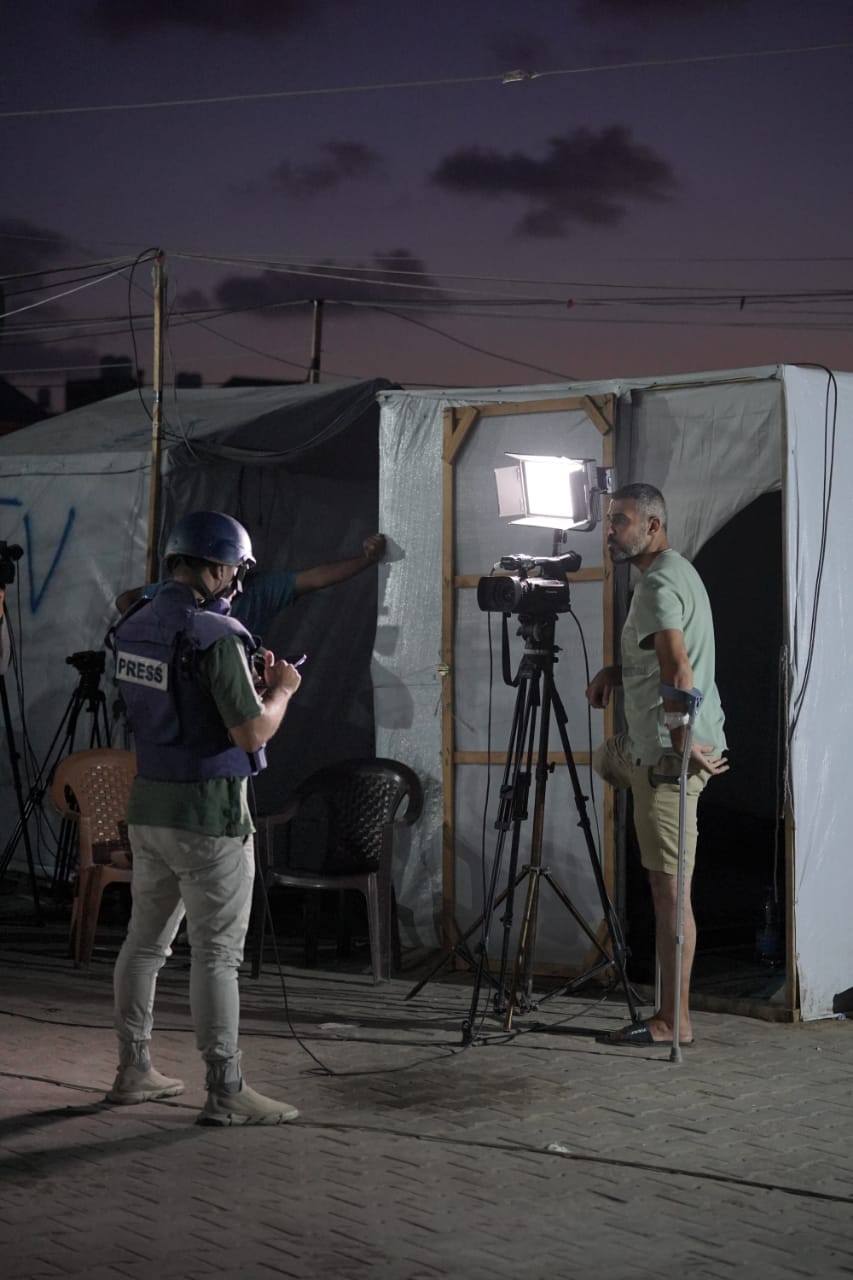Four Gazan journalists reflect on how it feels to be reporting after nearly 20 months of war .
When military operations in Gaza began in October 2023, there were 1800 working journalists and 24 local media organizations operating within the strip, according to journalist non-profit Palestine Journalism Hub (PJH) director Shuruq As’ad. She tells iMEdD that all 24 have now shuttered, and 112 press offices – that is, all of them – were bombed. 300 journalists left Gaza and 117 are in detention.
Those that remain and continue to work risking their lives feel their increased responsibility since no foreign media have been allowed independent access to Gaza since Hamas’ October 7 attack.
“I’m not coping with the mental trauma,” says 30-year-old journalist and filmmaker Shrouq Al Aila via voice message on WhatsApp. “The tears, the feelings, the mental breakdowns are all on hold and postponed to afterward because it’s never a suitable time to breakdown,” says Al Aila. “Never.”
‘Never Stop Learning’: Reporting on Yemen Beyond the Headlines

Reporting on Yemen has long been one of the most difficult and important tasks for investigative journalism. The years of conflict and political turmoil make it challenging but crucial to find accurate information and to properly represent its people.
A Casualty of War
Al Aila lost her husband, journalist Roshdi Sarraj, over breakfast at his mother’s house during the second week of the war, while they debated the dangers of his going to film an ambulance ride-along.
“I advised him to not to do the coverage inside the ambulance,” recalls Al Aila, who continues to produce news reports for France24, the BBC, ABC (the Australian Broadcasting Corporation), Al Jazeera, and others as the head of Ain Media, the production company her late husband founded. “And he told me, if I’m not documenting this, who’s going to document it?”
When the bombs began to fall in the Tel Al-Hawa neighborhood of Gaza City that morning, they ran to the basement. Al Aila cradled their 11-month-old, Dania, with one arm and held Sarraj with the other as the explosions drew nearer. Mere seconds before a bomb hit their house, Sarraj dropped his wife’s hand and moved in front of her, ultimately shielding Al Aila and their daughter from the blast.
Al Aila felt the weight of his body on her leg. When the dust cleared, she could see a crack in his skull around one centimeter wide. “I could see his brain from inside,” she says. “He was gasping, catching his last breath.” She and Sarraj’s brothers lifted him in their arms and ran, racing through the besieged streets still under bombardment to reach the hospital on foot. He died there a few minutes later.

A Lethal Profession
Sarraj is one of at least 181 (as of May 28, 2025) media workers that have been killed in the conflict, according to the Committee to Protect Journalists (CPJ), making it the deadliest war for journalists since data collection began in 1992. All but eight were Palestinian.
The Palestinian Journalists Syndicate, the 101-year-old labor union representing Palestinian journalists in Israel, the West Bank and Gaza, places the death count even higher, at 219. Speaking from Ramallah and Jerusalem, As’ad says that there has been a “systematic attack” on journalists in this war. The CPJ has determined that at least 17 journalists and two media workers were directly targeted by Israeli forces; it is investigating the circumstances around 20 other deaths.
“In Gaza journalism is not an ordinary profession – it is a daily battle to deliver the truth and staying alive while doing so is not guaranteed for any of us,” 20-year-old Malak A Tantesh, a soft-spoken former health science student, tells iMEdD in a voice message. Tantesh had barely completed one month of university, studying to become a physiotherapist, when war broke out; she is now the Gaza correspondent for the Guardian, NZZ and several other European newspapers.
Ansam El Qattaa, a digital journalist in Gaza City who has reported for a number of Arabic-language media outlets since her radio station was bombed in the first week of the war, is blunter.
“In Gaza City, it has become the profession of death,” the 34-year-old texts iMEdD via WhatsApp. “When I go out to do my journalistic work, the beating of my heart is louder than the sound of the bombing because of how scared I am.”

El Qattaa has no vehicle and goes out on foot to do her reporting. Her eSIM (and Gaza’s mostly destroyed telecommunications infrastructure) requires her to climb to higher ground to get a signal and file her story.
“I document stories while feeling great fear that I might lose my life at any moment,” she writes. She says it is her moral duty to continue reporting.
A Near Miss
The last story Sami Shehadeh covered as a camera operator for the Turkish Radio and Television Corporation’s Arabic service (TRT Arabi) was the one in which he lost his leg. Speaking via WhatsApp, the 37-year-old says he was wearing his press flak jacket and a helmet while filming interviews at the Nuseirat camp in April 2024 when a missile struck.
Shehadeh’s right foot was instantly severed; a colleague was lightly injured. More than a year later, Shehadeh has not been allowed to leave Gaza for surgery to receive a prosthetic limb and remove shrapnel from his hand.

“We tried every way to get out for treatment, but the Israeli army prevented me from leaving,” the father-of-two told iMEdD. He now helps file reports and films stand-ups from the TRT tent on the street.
Starvation as a Weapon

After 470 days of war and the ceasefire in January, Gaza’s aid routes reopened, yet severe shortages of essentials persist.
A Targeted Kill
Israel denies it intentionally targets journalists but also labels some as “terrorists… operating under the guise” of journalism. One of those was Hassan Eslaiah, who was killed during an air strike on a hospital in Khan Yunis in May 2025, where he was receiving treatment for injuries sustained during a previous attack that killed two and wounded eight on a journalists’ tent. He was the named target of both strikes.
“Journalist? More like terrorist,” the Israel Defence Forces (IDF) posted on their official X account on May 13, 2025, announcing Eslaiah’s death. “Don’t let Aslih’s [sic] press vest fool you: Hassan Abdel Fattah Mohammed Aslih, a terrorist from the Hamas Khan Yunis brigade, was eliminated along with other terrorists in the ‘Nasser’ hospital in Khan Yunis. Aslih participated in the brutal October 7 massacre under the guise of a journalist and owner of a news network. During the massacre, he documented acts of murder, looting, and arson, posting the footage online.”
PJH director As’ad says that “of course” Eslaiah was a journalist and a well-known one. He had freelanced for foreign news agencies and CNN before they cut ties with him after the IDF’s allegations, which he denied. As’ad defended Eslaiah’s coverage of the October 7 attacks as no different than the embeds of Israeli and foreign journalists entering Gaza with the IDF.
No Safe Zones
Al Aila says the evacuation orders issued by the IDF make getting to stories both difficult and deadly, as the no-go areas expand and residents are cordoned into ever-shrinking “safe” zones that often do not connect with each other. But to upload footage, Al Aila has to trek to a journalists’ tent with fast internet, usually next to a hospital, passing through areas that are considered out of bounds for civilians.

“I always wonder,” says Tantesh, who sometimes hires a donkey cart to travel to a story, “Is it possible that I will return to find the bodies of my family in pieces, or lifeless or burnt? While I’m outside, I remain terrified that the strike could happen nearby or right where I am, that I could be injured or killed and recorded as an unidentified martyr.”
Dwindling Food Supplies
All the journalists iMEdD spoke with say that food – finding it, paying for it, and preparing it (cooking gas is unavailable) – is always at the top of their minds. They make do with one or two meagre meals a day. The latest report from the United Nations-backed Integrated Food Security Phase Classification (IPC) says one in five Gazans are at severe risk of starvation.
“We eat once a day to satisfy our hunger and (because of) its high prices,” says Shehadeh. The day he spoke with iMEdD the meal of the day consisted of plain boiled rice. He says it is impossible to get milk for his girls, even though he is one of the lucky few who still get a salary. But that salary sits in a bank that has been closed since the start of the war.
Because of the shuttered ATMs, moneylenders have sprouted throughout the enclave, offering cash in exchange for a 30 percent fee. Israel’s 11-week food and aid blockade caused prices to skyrocket: a bag of flour costs 300 US dollars, and a liter of gasoline 80.
“We are facing challenges we never knew existed,” Tantesh says.
Dreaming of a Future
Despite the immense hardship and loss, none of the four journalists iMEdD spoke to said they wished to leave Gaza. And all of them said they still had hope for the future.

“I love life so much, and I fight every day just to stay alive, holding on to big dreams that I hope to achieve,” El Qatta says. She told iMEdD her goal is to get a master’s degree abroad.
Tantesh also dreams of going to university. “I don’t even know what will happen to us in the next five minutes,” she says. “But if the war ends and we survive it, I will go out, go abroad to start my university studies and then I will return to Gaza again.”

